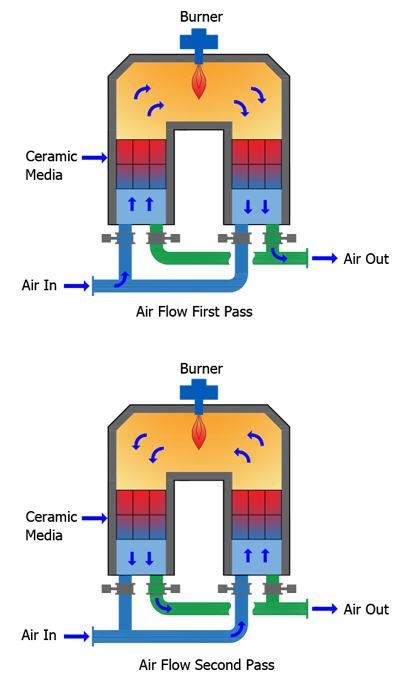In a Regenerative Oxidizer, an effort is made to get the absolutely highest possible energy recovery. This type of design is aimed at low concentrations of organics. Since you can recover a very high percentage of the energy, you can operate with low fuel use. This has to be balanced against any cases where you might actually encounter much higher levels of inlet VOC which could overheat the oxidizer.
For low concentration of VOC, it becomes very important to minimize the energy use by the oxidizer itself. To do that, a set of ceramic media is used to heat the gas. The Oxidizer can have 2, 3, or more chambers containing this heat exchange media. As the gas enters the chamber, the media will already have been heated up to a high temperature so the ceramic media will heat up the gas as it passes over the media. The gas then enters a chamber where the burner raises the temperature up to the actual operating point. The hot gas then goes out through another chamber where the media is cooler and the gas out heats up this media.
After operating for several minutes, the hot ceramic media will cool and to maintain the efficiency, the direction of the gas is reversed so that the gas now passes over the previous exhaust side media and is heated. By continually switching the direction of the gas ever few minutes, the different beds are kept relatively warm and efficiencies of 80%, 90% or higher percent thermal efficiency can be obtained.
A balance needs to be maintained between the recovery of energy and the amount of inlet VOC. It is possible to have too much energy and then the system will shut down because the temperature will continue to increase as all the energy is kept inside of the chamber. You need the best combination of efficiency maintaining a stable operation by not recovering excessive amounts of the energy. You also want a design that uses the best type of ceramic media for the chemical resistance required as this can vary from application to application.
There is no one specific media that is best. There are combinations of different media that can be used including structured Honeycomb ceramics and random packing type ceramics. There are different grades of ceramics. Branch can offer a wide variety of different internals to meet the best combination of thermal efficiency and stable operation.
Where other compounds such as organics containing Halogens are present, Branch can provide a single source system to not only destroy the unwanted contamination but also to remove the resulting acid gases from the exhaust. Branch engineers will help you select the best combination of components for your application.
- All performance levels are guaranteed.
- Any design configuration can be provided, including vertical and horizontal.
- All safety features with UL, FM or other approved components as needed.
- Complete engineering, including tail gas treatment from one source.
- Shop fabricated capacities of up to 40,000 cfm / 68,000 m3/h) are available.
Packaged Systems
For some applications on oxidizers, the destruction of the compound results in other chemicals which can still not be released to the atmosphere. For example, if you destroy a chlorinated organic, the final flue gas may contain HCl (Hydrochloric acid). If the quantity of HCl is significant, we can add a cooling system and a scrubber system to eliminate any acid emissions and convert the acid HCl to a neutral salt. Branch Environmental can provide the complete coordinated package since we design both the oxidizer and the scrubber. You have one single source of responsibility.


